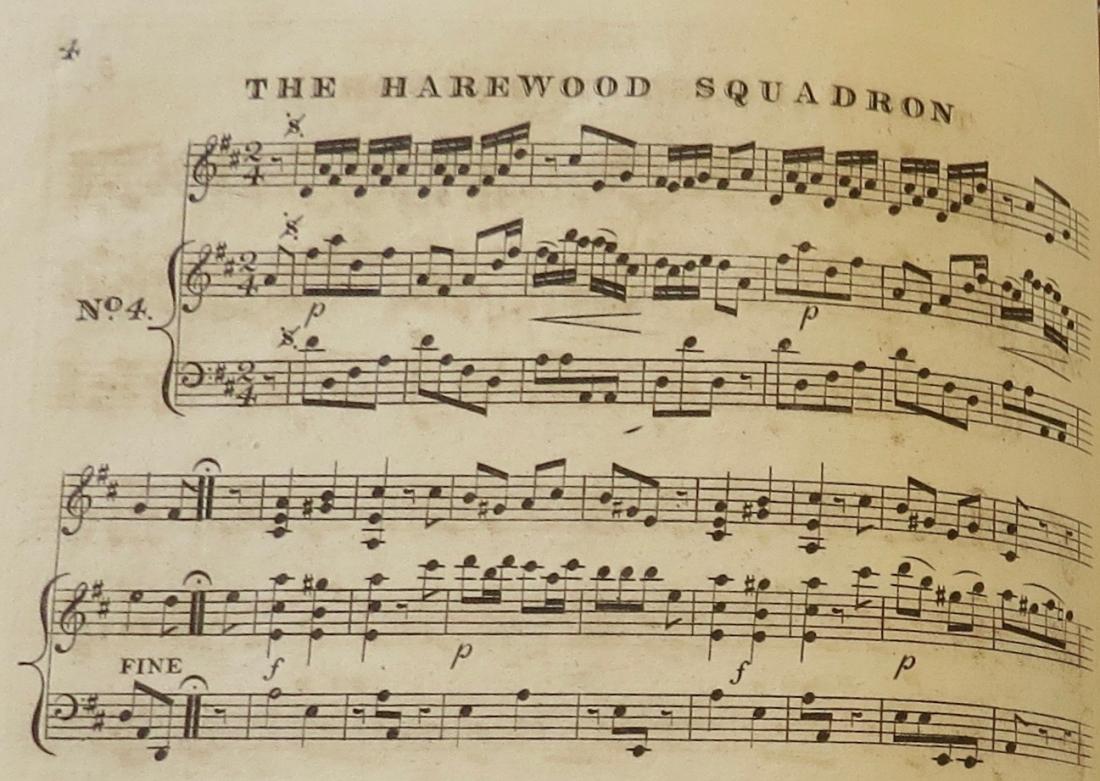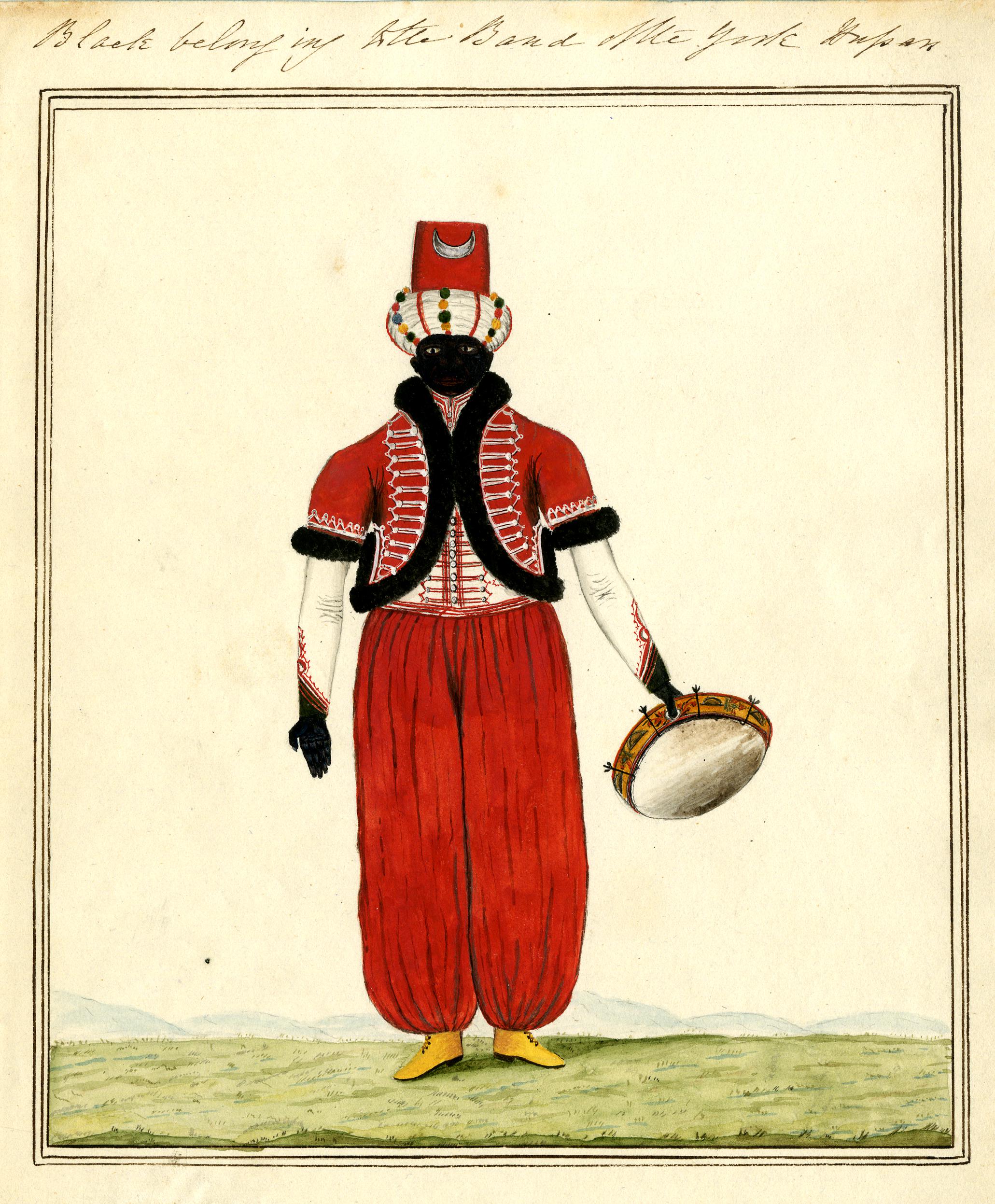
A. Roy: The Yorkshire Hussars Quadrilles (1822)
The Yorkshire Hussars. A Favorite New Set of Quadrilles, as Performed at the Ripon Winter Assemblies. Composed & Respectfully Dedicated (by Permission) to Colonel The Right Honble Lord Grantham, Major Wood, T. Hutton, and J. Howard Esqrs Managers 1821-22. Arranged for the Piano Forte or Harp, with a Violin Accompt & so as to be Played by Two Violins & a Bass, or a Flute and a Violin by Andw. Roy, Band Master & Leader of the Band at the above Assemblies (London: Published for the Author by Goulding, D’Almaine, Potter & Co., [1822]).
The Ripon Squadron – The Knaresboro Squadron – The Leeds Squadron – The Harewood Squadron – The Tadcaster Squadron
Image credit: 2008TW-2163. Houghton Library, Harvard University.
To download mp3 files either click on the three dots or right-click on the player and choose the save/download option.
Recording Details:
Wiebke Thormählen - violin
Sarah McMahon - cello
Jean Kelly - harp
Recorded at the Royal College of Music, London, 24 September 2021
SCORE: Yorkshire Hussars Quadrilles - arrangement using original piano/harp part
PARTS: Yorkshire Hussars Quadrilles - arrangement using original piano/harp part
SCORE: Yorkshire Hussars Quadrilles - adapted arrangement
PARTS: Yorkshire Hussars Quadrilles - adapted arrangement
The Yorkshire Hussar Regiment of Yeomanry Cavalry was raised in 1794 and although it was briefly disbanded in 1802 after the Peace of Amiens, several troops were subsequently reformed, including those at Knaresborough and Tadcaster. From 1819 the regiment was under the command of Thomas Philip Robinson, 3rd Baron Grantham. He clearly valued his men – in a letter to his wife, he reported that the Ripon squadron was “beautifully mounted, and so clean and soldier like and so proud of themselves. They are beyond question the finest part of the regiment in every point”. Across the years Lord Grantham inspected the different squadrons, including those situated at Leeds and Harewood (Stooks Smith 1853). Each of these squadrons are represented in The Yorkshire Hussars through the names of the individual quadrilles.
Little is known about the composer of the quadrilles. Two possible candidates emerge from newspaper reports of inquests in Ripon. In 1845, an inquest took place for an Andrew Roy, known to be a violin maker, who died by suicide aged 70. The Yorkshire Gazette on 14 June stated that “until within the last few years [he] was master of the Yorkshire Hussar band, and was much respected by the musical portion of the city”. Fourteen years earlier, the bodies of Roy's son, also Andrew Roy, a cabinet maker and member of the Yorkshire Hussar band, and his beloved, Elizabeth Meadley, were found in the river Ure. They had been at a dance and upon return to Elizabeth’s house, Roy was forced to leave due to intoxication. Two flutes that he played on the evening of the dance were the first items to surface in the river. The younger Roy was about 27 when he died in 1831, which would have made him rather young to be a band master in the early 1820s.
Like many similar publications, The Yorkshire Hussars is an arrangement of a set of five individual quadrilles, to be danced to the most popular quadrille figures. The title page is unusual, however, in the amount of information it provides about instrumental possibilities. In addition to piano or harp with violin, the other combinations offered are two violins and a bass, or flute, violin and bass. These groupings are especially suitable for domestic performance and the quadrilles would have been marketed as such. A similar combination was recommended by Mrs William Parkes in 1825, when she wrote in Domestic Duties; or, Instructions to Young Married Ladies that “Violins, with harp and flute accompaniments, form the most agreeable band for dancing”.
The choice of violin, cello and harp for the recording is a variation on these possibilities based on the appearance of this combination in images from the 1810s onwards, such as the ensemble displayed in La Belle Assemblée in 1817. The recording presents the harp part as it appears in the original nineteenth-century arrangement, performed here on a single-action harp that allows for the rapid repetition of notes and runs at dance tempo.
We have provided arrangements in scores and parts in two separate versions. The first presents the harp part as in the original source with violin and cello added. The second presents the harp part minimally altered to capture its role as the melody carrying instrument whilst making it more playable on a modern harp. We hope that performers will be inspired to study both and to use the latter arrangement as a basis upon which to weave together the violin, cello and harp in such a way that neither the dance tempo nor the character will be impeded by demands on the instrumentalists. You can read more about the general approach to performing practices in this music and to the specific issues encountered by the differences between the early nineteenth-century harp and the modern harp in Performing Practices Lost and Found.
The copy we used is part of a bound volume of piano music, largely consisting of dance compositions, which is labelled “Mrs T. Hutton”. This is possibly Elizabeth Chaytor of Spennithorne Hall in Yorkshire, who married Timothy Hutton of Clifton Castle in 1804. Hutton was one of the managers of the Ripon Winter Assemblies as listed on the title page and was involved with the Yorkshire Musical Festival.
Further Reading:
Stooks Smith, Henry. 1853. An Alphabetical List of the Officers of the Yorkshire Hussars, from the Formation of the Regiment to the Present Time. London: Simpkin, Marshall, and Co.
Newspaper References:
Inquests for Andrew Roy: Leeds Intelligencer 25 August and 1 September 1831; Sheffield Independent 3 September 1831
With thanks to the Roy family for kindly sharing information about their ancestors.

‘Black belonging to the Band of the York Hussars’, c.1820-1900 © The Trustees of the British Museum.
